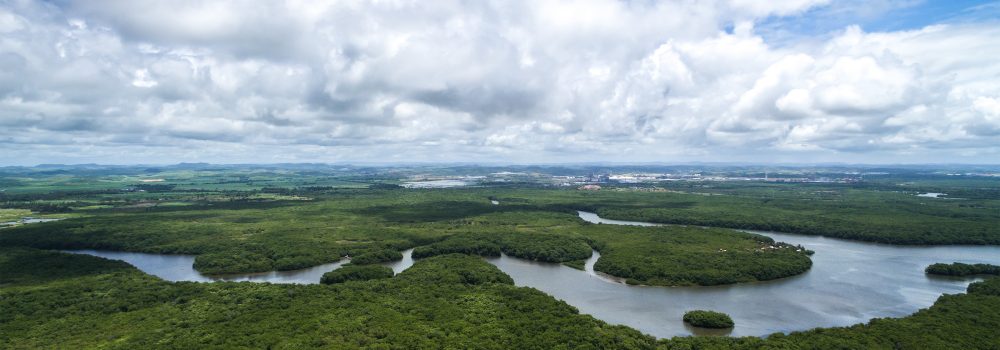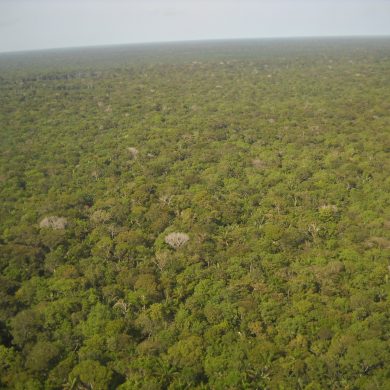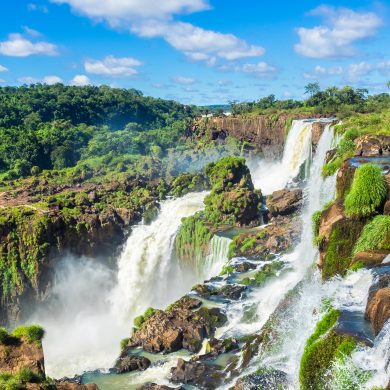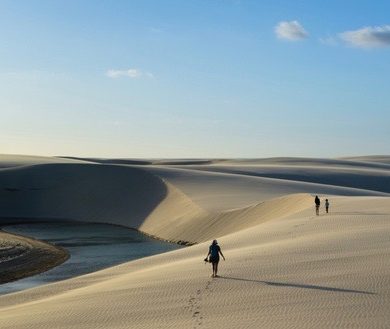The Amazon is the largest territory in Brazil and is a unique phenomenon that make Brazilian geography truly special.
Spanning over several million kilometers, this tropical forest is intersected by gigantic rivers such as the Amazon and Rio Negro. A veritable lung of the world, the Amazon rainforest is a natural bastion for many endangered species. Brazil retains 63% of the Amazon rainforest, with Peru, Colombia and, to a lesser extent, Ecuador, Venezuela, Suriname, Guyana, Bolivia and French Guyana sharing the remaining 27%.

The Amazon, a vast plain covered with rainforest
The Amazon consists of a vast plain covered almost entirely by the tropical forest. This area of Brazil, considered as the lungs of the planet, covers nearly 5,500,000 square kilometers. The region is characterized by a climate which is both hot and humid which allows the development of a unique biosphere. The Amazon rainforest produces 15% of the world’s river water and significantly curbs climate change thanks to its immense capacity to absorb CO2. The Amazon is a refuge for many threatened species such as the jaguar and the giant otter. It is home to 10% of the world’s animal population.
The Amazon in Brazil is mostly shared between two of Brazil’s largest states, Amazonas and Pará, which are irrigated by the Amazon River and its hundreds of tributaries. At 6,437 km, it is the longest river on Earth along with the African Nile.

A region bathed by the waters of the Amazon and Rio Negro
The Amazon River is distinguished by its length and the expanse of its basin which covers 40% of the South American continent, approximately 6 112 000 km2. There is no bridge or dam to cross the Amazon in Brazil, as its bed is too wide and deep. The source of the river is in the Peruvian Andes, from which it crosses the continent from West to East literally cutting Brazil in half before pouring into the Atlantic Ocean.
The Rio Negro is one of the most important tributaries of the Amazon. It starts its trip in Colombia before diving into the Amazon in Manaus, Brazil. The river is characterized by the black colour of its waters, due to a high concentration of iron and organic matter. Rio Negro is the largest blackwater river in the world.
The development of green tourism to preserve the Amazonian ecosystem
Brazil, recognizing its natural assets, has in recent years developed a new form of tourism. With growing awareness of the ecological importance of the Amazon at a global level, the country has put many conservation processes in place. The ecolodges are a perfect example of how Brazil wants to develop the tourism economy in this region, in perfect harmony with its natural heritage.

THE STATES OF AMAZON
Whether in Pará , Amapa , Roraima , Acre or Amazonas , the climate is hot and very humid, a direct consequence of the immense ecosystem of the ubiquitous forest. The forest has the largest specific biodiversity in the world, and is home to more species than the rainforests of Africa and Asia. As the largest rainforest region in the Americas, one of every ten animal or plant species in the world lives in the Amazon rainforest – the largest collection of animals or plants on the planet.
Amazonas
Amazonas is the largest state of Brazil with an area of 1.664 million km². It is essentially covered by the Amazon rainforest. Comprising of nearly 390 billion trees and 16,000 different species, this forest is the largest reservoir of biodiversity in the world. There are nearly 60 times more “adult” trees in the Amazon rainforest than human beings all over the planet. This natural wealth is unfortunately threatened by deforestation, a damaging effect owing to aspects of poorly controlled economic activity. In order to preserve this ecosystem, Brazil has invested in the conservation complex of the central Amazon.
Manaus
The capital of Amazonas, Manaus, is the largest city in the Amazon, it is huge and modern housing more than two million inhabitants. Its rich past is still present in many of its monuments which allow great sightseeing opportunites. The city experienced its golden age in the nineteenth century with the exploitation of rubber whose extraction has benefited the entire automotive industry worldwide. It is now a special area where industrial taxes have been reduced to stimulate the local economy. Thanks to this measure, it has regained a good momentum and now plays a decisive role in the national economy. It ranks third in size in terms of Brazilian industry, after the two big Carioca and Paulista rivals of the South of the country.
Para
With an area of 1,247,689 km2, Pará is the second largest state in the country. Its area is larger than that of France and England combined. Pará is bordered by Suriname, Guyana and Amapá states to the north, the Atlantic Ocean to the northeast, the state of Maranhão to the east, Tocantins to the southeast, Mato Grosso to the south, Amazonas to the west and Roraima to the northwest.
Also mostly occupied by dense jungle, it nevertheless opens onto the Atlantic Ocean via an immense estuary of the Amazon River. The state economy is mainly based on the exploitation of natural resources, in particular mineral (iron, bauxite, manganese, limestone, gold, tin) and lumber. The other main sectors are agriculture, livestock, industry and tourism.
Belem
Founded in 1616 by the Portuguese colony, Belém is the state capital of Pará. It is the largest city in the North region of Brazil (1,323,000 inhabitants). It is a large industrial port enclave at the confluence of the rivers Acara and Guama in the complex estuary of the Amazon that opens at the Atlantic, a few hundred kilometers away. It is a city totally immersed in the richness of the Portuguese architecture of the sixteenth and seventeenth century, and a guardian of North Brazilian culture and gastronomy.
The island of Marajo
Marajo is the largest island in the world surrounded by fresh water, it is about the size of Switzerland! It is also an ecosystem of exceptional richness and diversity. Very flat, barely 10 meters of average altitude, it offers to the west a semi-submerged equatorial forest. This forest is almost impenetrable except by pirogue accompanied by a guide. Its wildlife is lush, especially during the rainy season (January to September) when entire companies of migratory birds from North America come to find refuge in this haven of peace.
On the other side of the island of Marajo, there is a vast territory of swamps and meadows. The island, populated by peasants and a few traders in its largest city, Souré, survives mainly from fishing, agriculture and of course tourism.
Acre
Nestled in the southeast between Bolivia and the Amazon , the state of Acre is an extension of the Amazon rainforest that comes crashing against the foothills of the Andes. It was also the last part of the Brazilian territory to be incorporated into the country, in 1904. The area was the stage of a war between the two countries which disputed the wealth resulting from the extraction of gold and rubber from the region.
Roraima and Amapa
North of the Amazon are the two unique states of Roraima and Amapa. Roraima, to the north, is the northernmost state of Brazil, most of which is above Ecuador. Much of the land is inaccessible and 70% of the state is occupied by the Amazon rainforest. The economy is based on agriculture and crops, livestock and the extraction of wood, gold and diamonds.
Located further east of Pará, the state of Amapa is distinguished by a linguistic particularism: in 1999, the teaching of French was made compulsory in public schools, as the result of a federal law requiring schools in the country to teach at least one foreign language. This is unsurprising given its immediate proximity to French Guiana in the north. This administrative measure was made by Amapa the only Brazilian state with a francophone trend, although French is now spoken little compared to Portuguese.






